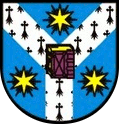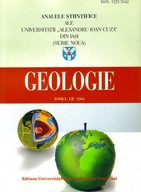
English title
- SERIA
GEOLOGIE (AUI-G) - |

|
| Log in New account |
| Home | Main Page | Guide for Authors | Peer Review | New Articles | Events | Archive | Index | Contact us |

|
Guide for Authors
Language
Articles and abstracts of AUI-G must be in English.
Title Page
The title page should include:
(a) A concise and informative title (size 12, Bold, Times New Roman, sentence case, single-spacing); (b) The name(s) of the author(s) (size 11, Times New Roman, each word capitalized, single-spacing); (c) The affiliation(s) and address(es) of the author(s) (size 10, Times New Roman, single-spacing), below the names; indicate all affiliations with a lower-case superscript letter immediately after the author's name and in front of the appropriate address; provide the full postal address of each affiliation, including the country name; provide the first author’s (corresponding author) e-mail address. Abstract and keywords
The abstract should have between 150 and 200 words, size 10, Times New Roman, single-spacing, justified; it should state briefly the purpose of the research, the principal results and major conclusions. The abstract has to be followed by 4 to 10 keywords; only abbreviations firmly established in the field may be eligible.
Text Formatting
Manuscripts should be submitted in MS Word; margin width has to be 1.5 cm – top and bottom, 1.8 cm – inside, and 1.5 outside (mirror margins), on custom sized sheets of 24 cm height and 17 cm width. The format of the text is required to be: single-spacing, size 10, Times New Roman, justified. First line of the paragraph should be indented by 0.6cm.
Divide your article into clearly defined sections, e.g. Introduction – Geological setting (Site description) – Materials and methods/techniques – Results – Conclusions.
Citation
Cite references in the text by last name and year in parentheses.
Examples:
References
The list of references should only include works that are cited in the text and that have been published or accepted for publication. Personal communications and unpublished works should only be mentioned in the text. Do not use footnotes or endnotes as a substitute for a reference list. Reference list entries should be alphabetized by the last names of the first author of each work. References published in any other language than English should be translated in English; at the end of reference, the original language must be specified.
The format of references must be single-spacing, size 8, Times New Roman, justified, hanging by 0.4 cm.
Examples:
Boon, M., Heijnen, J. J., 2001. Solid–liquid mass transfer limitation of ferrous iron in the chemical oxidation of FeS at high redox potential. Hydrometallurgy, 62, 57–66.
Curtis, C. D., 2000. Mineralogy in long-term nuclear waste management. In: Vaughan, D. J., Wogelius, R. A. (Eds.), (2000). Environmental Mineralogy. European Mineralogical Union.
Doe, J., 1999. Title of subordinate document. In: The dictionary of substances and their effects. Royal Society of Chemistry. http://www.rsc.org/dose/title of subordinate document; accessed: Jan 15, 1999.
Pál-Molnár, E., 1998. Geology and petrology of Ditrău Syenite Massif with special respect to formation of hornbldendite and diorites. PhD. Thesis, University of Szeged, Hungary.
Popescu, I., 1989. Mineralogy and petrography of Muntele Mare granite body (Apuseni Mountains). An. Șt. Univ. "Al. I. Cuza", XX, 15-25, Iaşi. (In French).
Tables
All tables should be numbered using Arabic numerals and cited in text in consecutive numerical order. The format of tables and headings is required to be: single-spacing, size 9, Times New Roman, justified. For each table, please supply a table heading. The table title should explain clearly and concisely the components of the table; the title begin with the term "Tab.", followed by the table number; no punctuation is to be included after the number, nor is any punctuation to be placed at the end of the caption. Identify any previously published material by giving the original source in the form of a reference at the end of the table heading.
The table should appear as in the following example:
Example:
Tab. 4 Temperature of biotite from pegmatite bodies (Preluca Pegmatite subprovince)
Artwork Guidelines
Please submit all of your artwork – photographs, line drawings, etc. – in an electronic format. Name your figure files with "Fig" and the figure number, e.g., Fig1.eps.
Regardless of the application used, when your electronic artwork is finalized, please "save as" or convert the images to one of the following formats:
Black and white graphic with no shading: do not use faint lines and/or lettering and check that all lines and lettering within the figures are legible at final size; vector graphics containing fonts must have the fonts embedded in the files.
Photographs, drawings, or paintings with fine shading: if any magnification is used in the photographs, indicate this by using scale bars within the figures themselves.
Figure lettering: to add lettering, it is best to use Helvetica or Arial (font smaller than 9 pt.); avoid effects such as shading, outline letters, etc.; do not include titles or captions within your illustrations. Make sure you use uniform lettering and sizing of your original artwork.
Figure numbering: : all figures are to be numbered using Arabic numerals; figures should always be cited in text in consecutive numerical order; figure parts should be denoted by lowercase letters (a, b, c, etc.).
Figure captions: each figure should have a concise caption describing accurately what the figure depicts; the format of figure captions is required to be: single-spacing, size 9, Times New Roman, justified; figure captions begin with the term "Fig.", followed by the figure number; no punctuation is to be included after the number, nor is any punctuation to be placed at the end of the caption; identify previously published material by giving the original source in the form of a reference citation at the end of the figure caption.
Please, produce images near to the desired size of the printed version. The width of artworks should not exceed either 66 mm or 137 mm; the height of the figure should not exceed 190 mm, caption included.
Prior to submit a manuscript, please read carefully the Peer Review section.
| ||||||||||||||||||||||||||||||||||||||||||
copyright © 2024 Department of Geology |